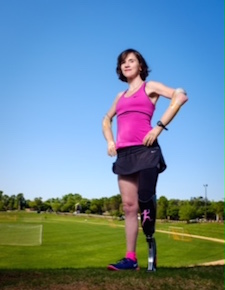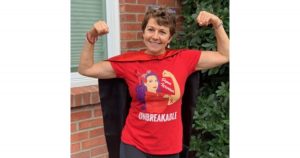“Your Ordinary is Extraordinary” – Limb Loss and Limb Difference Awareness Month
April 8, 2022
“Your Ordinary is Extraordinary” is the theme for Limb Loss and Limb Difference Awareness Month 2022. People with limb loss and limb differences have to adapt to many challenges as they go about their daily lives. Things that others take for granted can take significant – even extraordinary – effort for someone who has lost a limb. So what do we mean by your ordinary is extraordinary? And what if someone who has lost a limb doesn’t feel extraordinary?
Sepsis Alliance spoke with four sepsis survivors who experienced limb loss for their perspective.
Kristan Seaford

Kristan Seaford, from Charlotte, N.C., developed sepsis in 2013. She is considered a triple amputee, although Kristan has said in interviews that it’s really 3.5 because half of her remaining foot was also amputated. As an avid runner and fitness instructor in weight training and athletic conditioning, Kristan was used to being active before she became ill.
Learning how to cope with limb loss and use her prosthetics helped Kristan live a relatively “normal” life, she wrote in her Faces of Sepsis™ submission. She doesn’t think about it a lot, but she can see why some people may see her actions as extraordinary. “I generally send texts/emails by typing with my elbow,” she said in an interview. “To me, that’s just the way I send a text. But I’m often reminded that this act that’s ordinary to me can be seen by others as extraordinary.” Kristan added that the same thing happens when she applies her eye make-up while her sister watches. “To me, that’s just getting ready for work,” she said. “But she’ll sit there just mesmerized by what I can do with my ‘stubs’.”
But Kristan also said that getting to a point when you’re confident doesn’t come easily or quickly. “Many people think that if you lose a leg, you just get a prosthetic leg and you are on your way,” she said. “No one has a clue how hard it is to get a perfect fit and/or how many prosthetics you’ll have to go through to figure out the best one for you.”
Rusty Wagstaff

Rusty Wagstaff, from Wendell, N.C., also survived sepsis in 2013. He lost both legs below the knees, his right arm below the elbow, and his left hand. It was a shock when he woke up from a coma to a new permanent reality, he said. But he knew that he would be able to find ways to live his life again, just in a different way. “The biggest thing I can tell people is to look at it as a new challenge in your life,” he said. “This may sound silly, but every day I try to figure out how to do things in a different way, for example, like when I trim hedges. I have to think of a different way to hold the hedge trimmer. I try to put a positive spin on it.”
He does get embarrassed sometimes about the attention. But being told he’s an inspiration does make him feel good. “Maybe they’ve had a hard day or something and they look at me and think, well, it could be worse.” Rusty uses his experiences and his outlook on life to help support sepsis awareness. He was named a 2020 Sepsis Hero for this work.
Katy Grainger

Katy Grainger, a member of the Sepsis Alliance Board of Directors and a sepsis survivor, lived on the island of Kauai, Hawaii, when she lost both legs below the knee and seven fingertips in 2018. Now a busy advocate for sepsis awareness and education, Katy had to relearn how to walk, ride a bike, drive, and even do stand-up paddling, after her limb loss. But it didn’t come easily. “Since I had my amputations, I do feel like everything I do takes an extraordinary effort,” she said. “I have to find a way to go about my life similar to how I did before but, literally, everything I do takes extra time, planning, effort, and physical and mental discomfort.”
Not Everyone Feels Extraordinary
Katy feels that her new life, challenges and all, is extraordinary. “Viewing it this way gives me strength and confidence that I can overcome the many obstacles I encounter as an amputee.” But what about those with limb loss who are struggling, who don’t feel like what they are doing is extraordinary, that it’s just surviving?
“In our culture, the main theory of disability has been that it’s a personal tragedy,” said Lindsay Boudreau, LICSW, a psychotherapist in Orange, MA, who works with people who experienced limb loss. She, too, is a post-sepsis amputee. “The message of your ordinary is extraordinary is helpful in moving away from it being something that’s horrible and needs to be pitied.”
For those who are struggling, asking for help is not something to be ashamed of, no matter how recent or old the amputation is. There are groups across the country, in-person and online, that can help amputees adjust to their new reality. Lindsay said that finding that community of people who understand the experience can be invaluable. “You can get a sense of where people are in their process, and see and gain inspiration, but you can also get support.” Lindsay said she still goes to a group occasionally. “Having people who understand, have been there, and can provide true understanding is really vital,” she added.
Some things are just too hard for some amputees, Lindsay acknowledged. And if someone feels that the message of “your ordinary is extraordinary” doesn’t fit, perhaps going back to recognizing achievements they have accomplished can help them see how far they have come since the amputation occurred. They may not realize how extraordinary their journey is.
Would you like to share your experience with others? You can submit your story here.
To learn more about how sepsis and septic shock can lead to amputations, visit Sepsis and Amputations, part of the Sepsis and… library.





























